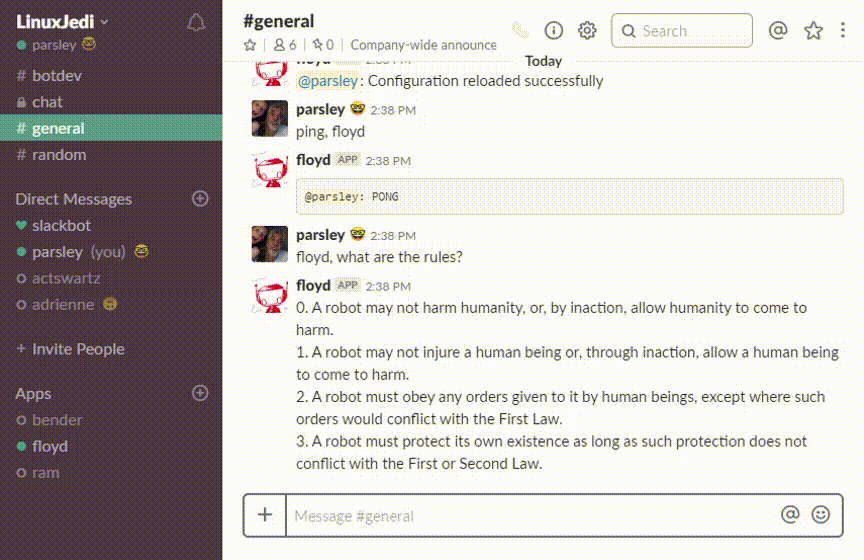Gophers + Robot by Renee French (cropped) licensed under Creative Commons License 3.0
Gopherbot DevOps Chatbot
Enterprise Slack(*) DevOps / ChatOps / CI/CD bot for Linux, supporting plugins in Go, Python, Ruby, and Bash
Slogans under consideration:
- The Co-worker that Never Sleeps
- The DevOps Swiss-Army Chainsaw
Latest Release
Download the current release from: https://github.com/lnxjedi/gopherbot/releases/latest
NOTE: Version 1 is getting pretty old. I've been running the core of Version 2, heavily using pipelines and encrypted secrets, for about a year now. I'm in the process of breaking/fixing things that have become obvious over the last year, in preparation to release v2 in early 2020. If you've been using v2-snapshot, it's probably been bumpy.
Documentation
The latest documentation for Version 2 is on Github Pages: https://lnxjedi.github.io/gopherbot
Documentation for v1 can be found in the /doc subdirectory of the archive.
(*) with a modular interface for writing other protocol connectors in Go
Gopherbot Version 2.0 (Unreleased)
Documentation and tests for version 2 are not yet finished, but configuration and API interfaces have settled to the point that the 2.0 snapshots are worth a look. Though it is stable and running in production for me, 2.0 is mostly for current users that are willing to do some digging around until documentation is finished and it's had more time to ripen. There will be a few more breaking changes before a full release.
New Features
The biggest driver for version 2 is to remove the need for a separate CI/CD system. While Gopherbot couldn't replace Jenkins for many shops, it's very lightweight and perfectly adequate for many automated build / test and scheduled job workloads. Gopherbot is already building, running tests, and publishing itself; .circleci is only kept around to publish coverage results in a CircleCI-specific way. For a peek at GopherCI pipelines, compare the contents of .circleci to .gopherci.
Incomplete list of features new in 2.0:
- API support for pipelines and CI/CD operation (see gopherci)
- Rocket.Chat adapter
- Scheduled job support
- Job histories
- Encryption for secrets and the robot's brain
- Configuration merging custom with installed defaults; maps are merged, arrays are replaced
- New default configuration and a wide selection of included external (script) jobs, plugins and tasks
- Go template substitutions in configuration files for e.g. includes, referencing environment variables or decrypting secrets
- An Ansible Playbook
- First-class container support; ability to bootstrap a robot with a few environment variables and no persistent volumes
- Go loadable modules, enabling new Go plugins at runtime
Features since 1.x:
- Built-in support for elevated commands requiring MFA (ala 'sudo')
- A prompting API for interactive plugins
- Comprehensive set of administrative commands
- Support for simple single-file script plugins
Breaking Changes
Breaking changes are documented in the new manual
Deprecated and Unsupported Platforms
The Windows port has been removed; the only known use case is being replaced. Gopherbot should build on Darwin (Mac OS X), but since builds with module support won't cross-compile, archives are no longer being generated.
Documentation
With Version 2 nearly feature complete, documentation has become a priority. Watch https://lnxjedi.github.io/gopherbot for (hopefully) frequent updates. One of the best sources of documentation are the configuration repositories for Floyd (the production 'bot that builds all releases) and Clu (the devel 'bot that runs on my laptop); they can be found at Github.
Other than commented configuration files, most documentation is in the doc/src/ folder. Stuff in doc/src/Outdated is just that.
Sample Plugin with the Ruby API
#!/usr/bin/ruby
require 'net/http'
require 'json'
# NOTE: A bot administrator should supply the API key with a DM:
# `store task parameter weather OWM_APIKEY=xxxx`. Defaults for
# DEFAULT_COUNTRY and TEMP_UNITS can be overridden in custom
# conf/plugins/weather.yaml
# load the Gopherbot ruby library and instantiate the bot
require ENV["GOPHER_INSTALLDIR"] + '/lib/gopherbot_v1'
bot = Robot.new()
defaultConfig = <<'DEFCONFIG'
Help:
- Keywords: [ "weather" ]
Helptext: [ "(bot), weather in <city(,country) or zip code> - fetch the weather from OpenWeatherMap" ]
CommandMatchers:
- Command: weather
Regex: '(?i:weather (?:in|for) (.+))'
DEFCONFIG
command = ARGV.shift()
case command
when "configure"
puts defaultConfig
exit
when "weather"
location = ARGV.shift()
location += ",#{ENV["DEFAULT_COUNTRY"]}" unless location.include?(',')
uri = URI("http://api.openweathermap.org/data/2.5/weather?q=#{location}&units=#{ENV["TEMP_UNITS"]}&APPID=#{ENV["OWM_APIKEY"]}")
d = JSON::parse(Net::HTTP.get(uri))
if d["message"]
bot.Say("Sorry: \"#{d["message"]}\", maybe try the zip code?")
else
w = d["weather"][0]
t = d["main"]
bot.Say("The weather in #{d["name"]} is currently \"#{w["description"]}\" and #{t["temp"]} degrees, with a forecast low of #{t["temp_min"]} and high of #{t["temp_max"]}")
end
endContributing
I've started playing around with Gitpod for development, with good results. Sometime after the next batch of core updates, I'll work on stabilizing this again. For now, issues and pull requests welcome.
For development, testing, and collaboration, feel free to shoot me an email for an invite to the LinuxJedi Slack team.

